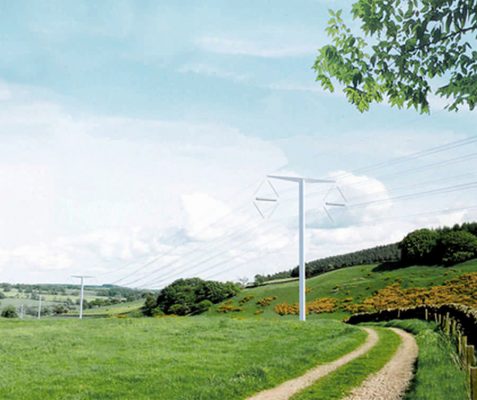Pylon Design UK, British architecture contest, England electricity infrastructure news
Pylon Design in the UK
Pylon Architecture in England, British Electricity Transmission Infrastructure
23 Jul 2013
New T-pylon offered for electricity transmission connection in the UK for the first time
• Secretary of State for Energy welcomes T-pylon as “a graceful, refined structure fit for the needs of our low carbon, 21st century.”
• Innovative new design of pylon to be considered for the Hinkley Point connection project in Somerset
• The shorter design of pylon is capable of carrying the 400 KV high voltage lines needed for the new connection
Pylon Design News
The T-pylon, which was selected in an international competition organised by the Department of Energy and Climate Change, Royal Institute of British Architects (RIBA) and National Grid, is being offered for the first time in the UK for a new electricity connection in Somerset.
The pylon, designed by the Danish architects and engineers Bystrup, was a clear winner in the field of 250 entries because of its innovative design features. The radical arrangement of the electrical components meant it could be lower than the equivalent steel lattice pylon and its simple design was judged to have less impact in many landscapes.
Engineers from National Grid and Bystrup have led a two year project to take the winning design through to construction of full sized prototypes. Earlier this year two types of pylon were built in Denmark which underwent mechanical strength and load testing. The insulators which hold the wires in places have been electrically tested in Sweden.
T-pylon
The T-pylon is designed to carry the highest voltage 400,000 volt lines that are needed for the Hinkley Point connection project in Somerset. The new pylon could be an alternative to the steel lattice pylon on other new major projects which will be connecting up low carbon and renewable generation to the grid. However it is not seen as a replacement for existing pylons, and there may be places where the traditional design remains the best choice for new projects.
The new design is a monopole with a T shaped cross arm – hence the name T-pylon. It is made up of fewer than 10 major sections and is designed for simple construction.
The pylon height was able to be lowered because of the innovative layout of the insulators and conductors (electricity wires) in a diamond “earring “shape. It meets the same safety clearances as the three-armed steel lattice tower but is 10 to15 metres shorter – the T pylon stands at about 35 metres.
Nick Winser, National Grid Executive Director said “The RIBA competition was held to find a design which would meet all our safety and reliability criteria and belong to the 21st century. The steel lattice pylon has served us well over the years and will continue to be part of the landscape but we’re looking forward to see people’s reaction to the new T pylon design”.
Secretary of State for Energy and Climate Change, Edward Davey said: “To see T-pylon becoming a reality just 20 months after winning the competition, is a fantastic achievement for National Grid and the Danish architects, Bystrup, and I’d like to congratulate them on their progress. One of the key objectives of the Pylon Design Competition was to see if innovations in design and technology could improve an 85 year old structure, and one that has divided popular opinion since its inauguration in the 1920s.
“We face a significant challenge over the coming years connecting new electricity plants to our homes and businesses. Now communities can be offered a new choice and a radical departure from the traditional lattice. A smaller pylon, one third shorter than its predecessor, with different finishes allowing it to blend into the landscape – T pylon is a striking and elegant design.
“I’m looking forward to seeing T-pylon put into service; a graceful, refined structure fit for the needs of our low carbon, 21st century.”
The Hinkley Point connection which runs between Bridgwater and Avonmouth is needed to carry all the new electricity generation planned for the Southwest. This includes the new nuclear Hinkley Point power station which, if it goes ahead, will be one of the largest single generators in the country.
For more information and to view a film about development of the T pylon http://www.nationalgridt-talk.com/
Pylon Design information from RIBA Competitions
14 Oct 2011
Pylon Design Competition Winner
New pylon contest winner unveiled
Bystrup’s innovative T-Pylon design has been unanimously agreed by the judging panel as the winner of the Pylon Design competition run by the Department of Energy & Climate Change, National Grid, and the Royal Institute of British Architects.
Location: England, UK
Electricity Pylon Designs
Electricity Pylons for the EdF, France
Design: Ian Ritchie Architects

photo from architect
Electricity Pylons
Pylon figures, Iceland
Design: Choi+Shine, Architects

picture from architect
Pylon Figures
UK Architecture
Building Competitions : Archive
Comments / photos for the Pylon Design in the UK page welcome

